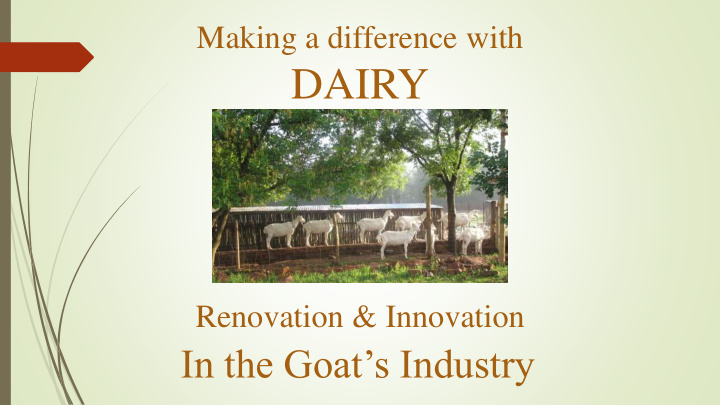



Making a difference with DAIRY Renovation & Innovation In the Goat’s Industry
Renovation
Goat’s Products Reputation in RSA? = DREADFUL
Historically not a product of Choice Most people in small towns/villages had dairy goats One or two Bucks and the collective herd grazed outside town Co-habitation of Does and Bucks plus Poor feeding regime plus Dirty goats = long memories of awful tasting milk, yoghurt and cheese
Most People associate Goat’s Milk Products with a ‘Barn – Yard’ Taste. This ‘Barn - Yard’ taste comes from: Mostly the Buck & it’s proximity to the Ladies Living conditions Cleanliness of animals – perspiration whiffs Food intake Handling of product
The RENOVATION All these matters are being addressed Farmers and Processors no longer accept the Barn- Yard phenomena as a ‘given’ The Industry has ‘cleaned - up’!! There is a pride in making products with just MILK – NOT milk tainted with perspiration and urine.
The Culprit!
The BUCK & the ‘Barn - Yard’ odour? Glands near the horns. Urine – which they spray on their face, beards, front legs and chest – intense when in rut. It contains a pheromone that turns on the Does reproductive system. Scientists have isolated the active ingredient - 4-ethyloctanal which converts to 4-ethyloctanoic acid when exposed to the air. Perfume manufactures would love to copy this. The Buck – sprayed with this ‘Old Spice’ is lovable and rubs his odour over the does. Its best to keep them well apart and allow minimum contact – just enough to allow pregnancy
Living Conditions
Cleanliness of Animals
Food Intake Provide sufficient roughage to promote rumen health and promote butter-fat Well formulated concentrate to provide balanced diet Feed generously to ensure goats feed enough and are stress-free Avoid any feed that can taint the milk and thus the taste of the products
Handling of Product Clean udders and milking equipment Gentle handling of milk Bring temperature down to 5ºC asap Preferably pasteurised Hygienic conditions – no contamination Food grade packaging Adequate chilling facilities
Another Factor that contributes is: Fatty Acids – short and medium chain Fatty Acids. Goat milk has almost 8 times as much. So much so that these fatty acids have distinctive Goaty names CAPRic, CAPRoic AND CAPRylic
Fatty Acids The fatty Acid aspects have plenty of purported health aspects but of note here is the taste it gives to Goat’s Cheese. A gorgeous full flavour that lingers long after the cheese is eaten. However, rough handling of milk during production & soft cheese past its sell-by-date can result in a ‘pronounced’ flavour that is not always pleasing!
Innovation
In the Beginning…..
There was a limited variety Feta Haloumi Chèvre Goat’s Gouda (eek!)
Large-Scale Production of Cheese standardisation of most large-scale produced cheese results in a certain loss in taste good eating is replaced by basic nutritional considerations and stimulated by appealing packaging, often concealing uniform products.
Small-Scale Cheese-making from Small Stock Large variances due to Geographic location Animal type Feed Seasons Non-standard cheese-making practices
246 Kind of Cheese? No – not really. Mainly variations on a theme. However – you do find high quality and originality – the hallmarks of Handcrafted Goat Cheese Goat’s Milk products lend themselves well to the individualistic artistry of each artisanal cheese-maker.
In South Africa? An explosion of small processors Wonderful new cheeses Great presentations And at last……. Our own individual cheese identities
Forest Phantom Crème de Fromage Kilembe Cream Cheese Chévre Iceberg
Thank You
Recommend
More recommend